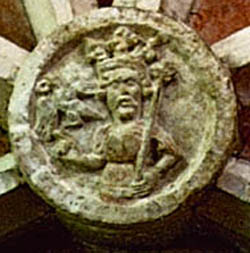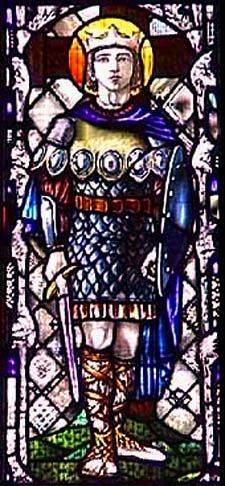 |
The Saint of the Day
St. Oswald of Northumbria – August 9
Prof. Plinio Correa de Oliveira
Biographical selection:

King Oswald of Northumbria. Where he was killed in battle, a well sprang up where many miracles were worked.
|
Oswald (605-642) was the son of Aethelfrith, King of Northumbria in England, during the time of the Heptarchy. His father was defeated in battle and killed, and King Cadwallon of Gwynedd, with the support of pagans, took power in Northumbria.
Oswald was forced to flee to Scotland, where he was converted to Catholicism by the monks of Iona. After some time, he assembled a small army, and in 634 he defeated the superior forces of Cadwallon and killed him in battle. Before the battle, Oswald ordered an enormous wood Cross to be made and planted on top of a hill in the army’s view. He recommended his men to pray to the God of the Christians so that the victory would be assured. From that time on, the place became known as “the field of Heaven,” because it was the first land in that kingdom to bear the Sign of Redemption.
Oswald was grateful to God for the victory and showed clemency toward the defeated soldiers. He became King of Northumbria and ruled the nation as a model Catholic king until 642, when he died in battle.
Comments of Prof. Plinio:
Here you have a historic fact that seems to be a legend: a Prince, heir to the throne, is forced into exile, where he converts to the Catholic Faith. Then he returns to re-conquer the kingdom from its usurper. He places a Cross on top of a mountain to inspire his army to prayer, and attains an extraordinary victory with the help of Heaven. It is so beautiful that one would say that it is a legend.

St. Oswald, a model Catholic king
|
There are innumerable facts like this in the Middle Ages that appear to be legends, but actually they are true. After that age, came Rationalism and Protestantism, and these beautiful facts seemed to disappear, and only what was natural was recorded. Now History is presented more as a nightmare than as a reality.
How can this transformation be explained? I think that it relies on a change in the human psychology itself. In an epoch where men had an elevated spirit, faith, and a sense of celestial things, they looked for ideal models on this earth and sought to perfect their actions. Heaven supported and confirmed their actions with miracles.
From the moment when they rejected that elevated vision of life and started to seek only what was human, what was proportional to man, Rationalism and Protestantism entered the picture. Supernatural events no longer were part of the day-to-day life, and History began to record only what was human. The hero in the era of Faith acted with the help of Heaven; the hero in the Humanist era counted on mere human capacities.
Next comes the era of the nightmares. Since man is not able to accomplish everything he needs to do by himself, when he rejects supernatural help, sooner or later he will ask help from the devils. The hero of this era of the nightmare is a man who makes extraordinary things, but with some occult help - no one can clearly explain from where it comes. We know. It comes from the devil. Then, either sooner or later, monstrosities begin to happen and are reported in History.
This is what is happening today.
We should overturn this process, open our souls to the supernatural and again act with reliance on Our Lady and her Angels in order to establish her Reign on Earth.
Let us pray to St. Oswald of Northumbria, whose life appears to us like a marvelous legend even though it was true, to help us re-conquer that innocence and sense of the celestial things that he had and transmitted in his life.


  | | Prof. Plinio Corrêa de Oliveira | |
The Saint of the Day features highlights from the lives of saints based on comments made by the late Prof. Plinio Corrêa de Oliveira. Following the example of St. John Bosco who used to make similar talks for the boys of his College, each evening it was Prof. Plinio’s custom to make a short commentary on the lives of the next day’s saint in a meeting for youth in order to encourage them in the practice of virtue and love for the Catholic Church. TIA thought that its readers could profit from these valuable commentaries.
The texts of both the biographical data and the comments come from personal notes taken by Atila S. Guimarães from 1964 to 1995. Given the fact that the source is a personal notebook, it is possible that at times the biographic notes transcribed here will not rigorously follow the original text read by Prof. Plinio. The commentaries have also been adapted and translated for TIA’s site.
|
Saint of the Day | Home | Books | CDs | Search | Contact Us | Donate

© 2002- Tradition in Action, Inc. All Rights Reserved
|
 |

|